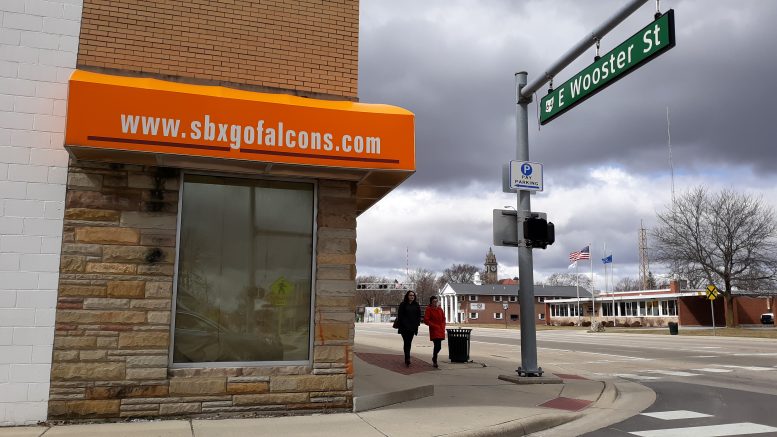By JAN LARSON McLAUGHLIN
BG Independent News
Bowling Green took the next step Wednesday toward attracting development in the new Gateway District between the BGSU campus and the city’s downtown.
The city is proposing that 2.76 acres it owns at the northwest corner of East Wooster Street and Thurstin Avenue be changed to the new Gateway District zoning classification. That space is currently occupied by the fire station and city’s electric division.
In an effort to make optimum use of that area between campus and downtown, the city is looking for properties to relocate the fire station and electric division. New locations have not yet been selected, said Municipal Administrator Lori Tretter.
Also on the list for rezoning is the city’s public parking lot off Manville Avenue, and two of the business locations in the southwest corner of East Wooster Street and Manville Avenue. The owners of the businesses at 518 and 522 East Wooster Street (Pita Pit and the former site of Inspector Gadget), Craig and Barbara Cheetwood, took the city’s offer to change the zoning for free.
Public hearings about changing those properties to Gateway District zoning will be held Dec. 2, at 7 p.m., in the city administration building.
City Council established the Gateway District earlier this year. The goal was to make better use of prime property for a more welcoming and functional facade to the city.
Though there has not yet been interest by investors in the area, Bowling Green Planning Director Heather Sayler said the rezoning of the property will make it ready for development.
“We’ve created the zoning, now we are getting it set,” Sayler said after Wednesday’s meeting of the city planning commission.
The new zoning category works under a different premise than much of the city’s zoning classifications. Instead of focusing on keeping undesirable land use out, this would focus on attracting desirable uses in.
It is being tried first in the city’s newly named Gateway District – the area along East Wooster Street between Thurstin/Manville and Enterprise streets.
Unlike much of the current zoning, the Gateway zoning discourages single-use buildings – so it would not allow buildings that are completely apartments.
The zoning follows the belief that people want areas to allow for personality, like more street trees, more bike and pedestrian pathways, more green space, and more places that look appealing. They want “street life” that includes outdoor dining on sidewalks, businesses on the first floor like a gym or coffee shop, and residential units above.
Parking garages will be encouraged behind some of the buildings, since paving huge parking lots is a waste of prime real estate. And the city will consider a requirement of bike parking spaces for each building.
City officials are looking at the area being used to make a statement about the community.
The statement would be made with buildings between three and six stories tall. The first floors of the buildings would be at least 16 feet tall in retail areas. The exteriors would be required to have lots of windows, and use similar building materials of brick, stone, metal, glass or wood. Vinyl siding would be prohibited.
Changes in signage rules are vital, with the Gateway District requiring smaller signs that meet certain standards. Parking garages will be preferred over parking lots, which are considered “dead space” if located in front of buildings.
The Gateway District will promote the development of a higher density, urban neighborhood center. Permitted uses would include:
- Whole building – conference center, hotel, and professional offices.
- Street level/first floor – bar or tavern, barber or beauty shop, child day care center, conference center, day spa, limited commercial, restaurant, retail sales, professional offices and retail services.
- Upper floor – condominiums, efficiency apartments, multiple-family dwellings, university-related residential, conference center, hotel, professional offices.
- Accessory – artisan manufacturing, check-in services for hotel, home occupation, residential amenities, swimming pool, parking lot, parking structure.

